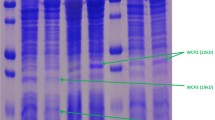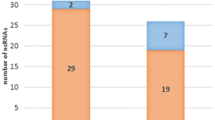Abstract
Virtually all bacterial species synthesize high levels of (p)ppGpp (guanosine penta- or tetraphosphate), a pleiotropic regulator of the stringent response and other stresses in bacteria. relA and spoT genes are, respectively, involved in synthesis and synthesis/biodegradation of (p)ppGpp. We aimed in this work to evaluate the impact of static magnetic field (SMF) 200 mT exposure on the expression of relA and spoT genes in Salmonella enterica Hadar. Bacteria were exposed to a SMF during 9 h, and RNA extraction was followed by reverse transcriptase polymerase chain reaction (RT-PCR). The relative quantification of mRNA expression levels using the 16S rRNA reference gene did not change during the SMF exposure. However, results showed a significant increase in gene expression for relA after 3 h of exposure (P < 0.05) and after 6 h for spoT (P < 0.05). The differential gene expression of relA and spoT could be considered as a potential stress response to a SMF exposure in Salmonella related to the production/degradation of (p)ppGpp.



Similar content being viewed by others
References
Cashel M, Gentry DR, Hernandez VJ, Vinella D (1996) The stringent response In Escherichia coli and Salmonella. cellular and molecular biology. ASM Press, Washington DC, pp 1458–1496
Haseltine WA, Block R (1973) Synthesis of guanosine tetra and pentaphosphate requires the presence of a codon specific, uncharged transfer ribonucleic acid in the acceptor site of ribosomes. Proc Natl Acad Sci USA 70:1564–1568
Battesti A, Bouveret E (2006) Acyl carrier protein/SpoT interaction, the switch linking SpoT-dependent stress response to fatty acid metabolism. Mol Microbiol 62:1048–1063
Vinella D, Albrecht C, Cashel M, D’Ari R (2005) Iron limitation induces SpoT dependent accumulation of ppGpp in Escherichia coli. Mol Microbiol 56:958–970
Mittenhuber G (2001) Comparative genomics and evolution of genes encoding bacterial (p)ppGppsynthetases/hydrolases (the Rel, RelA and SpoT proteins). J Mol Microbiol Biotechnol 3:585–600
Maisonneuve E, Castro-Camargo M, Gerdes K (2013) (p)ppGpp controls bacterial persistence by stochastic induction of toxin-antitoxin activity. Cell 154:1140–1150. https://doi.org/10.1016/j.cell.2013.07.048
Dalebroux ZD, Svensson SL, Gaynor EC, Swanson MS (2010) ppGpp conjures bacterial virulence. Microbiol Mol Biol Rev 74:171–199. https://doi.org/10.1128/MMBR.00046-09
Vrentas CE, Gaal T, Ross W, Ebright RH, Gourse RL (2005) Response of RNA polymerase to ppGpp: requirement for the omega subunit and relief of this re-quirement by DksA. Genes Dev 19:2378–2387
Ross W, Vrentas E, Sanchez-Vazquez P, Gaal T, Gourse RL (2013) The Magic Spot: a ppGpp binding site on E. coli RNA polymerase responsible for regulation of transcription initiation. Mol Cell 50(3):420–429
Hauryliuk V, Atkinson GC, Murakami KS, Tenson T, Gerdes K (2015) Recent functional insights into the role of (p)ppGpp in bacterial physiology. Nat Rev Microbiol 13(5):298–309. https://doi.org/10.1038/nrmicro3448
Wendrich TM, Blaha G, Wilson DN, Marahiel MA, Nierhaus KH (2002) Dissection of the mechanism for the stringent factor RelA. Mol Cell 10:779–788
English BP, Hauryliuk V, Sanamrad A, Tankov S, Dekker NH, Elf J (2011) Single molecule investigations of the stringent response machinery in living bacterial cells. Proc Natl Acad Sci 108:365-E373
Shyp V, Tankov S, Ermakov A, Kudrin P, English BP, Ehrenberg M, Tenson T et al (2012) Positive allosteric feedback regulation of the stringent response enzyme RelA by its product. EMBO 13(835):839. https://doi.org/10.1038/embor.2012.106
An G, Justesen J, Watson RJ, Friesen JD (1979) Cloning the spoT gene of Escherichia coli : identification of the spoT gene product. J Bacteriol 137:1100–1110
Xiao H, Kalman M, Ikehara K, Zemel S, Glaser G, Cashel M (1991) Residual guanosine 3′,5′-bispyrophosphate synthetic activity of relA null mutants can be eliminated by spoT null mutations. J Biol Chem 266:5980–5990
Potenza L, Ubaldi L, De Sanctis R, De Bellis R, Cucchiarini L, Dachà M (2004) Effects of a static magnetic field on cell growth and gene expression in Escherichia coli. Mutat Res 561:53–62
Cellini L, Grande R, Di Campli E et al (2008) Bacterial response to the exposure of 50 Hz electromagnetic fields. Bioelectromagnetics 29:302–311
El May A, Snoussi S, Ben Miloud N, Maatouk I, Abdelmelek H, Ben Aissa R, Landoulsi A (2009) Effects of static magnetic field on cell growth, viability, and differential gene expression in Salmonella. Foodborne Pathog Dis 6(5):547–552
Potenza L, Cucchiarini L, Piatti E, Angelini U, Dachà M (2004) Effects of high static magnetic field exposure on different DNAs. Bioelectromagnetics 25:352–355
Snoussi S, El May A, Coquet L, Chan P, Jouenne T, Landoulsi A, DÉ E (2012) Adaptation of Salmonella enterica Hadar under static magnetic field: effects on outer membrane protein pattern. Proteome Sci 10:6
Snoussi S, El May A, Coquet L, Chan P, Jouenne T, Dé E, Landoulsi A (2016) Unraveling the effects of static magnetic field stress on cytosolic proteins of Salmonella by using a proteomic approach. Can J Microbiol 62(4):338–348
Mihoub M, El May A, Aloui A, Chatti A, Landoulsi A (2012) Effects of static magnetic fields on growth and membrane lipid composition of Salmonella typhimurium wild-type and dam mutant strains. Int J Food Microbiol 157(2):259–266
Ben Mouhoub R, El May A, Cheraief I, Landoulsi A (2017) Influence of static magnetic field exposure on fatty acid composition in Salmonella Hadar. Microb Pathog 108:13–20
Ben Mouhoub R, El May A, Boujezza I, Sethom MM, Feki M, Landoulsi A (2018) Viability and membrane lipid composition under a 57 mT static magnetic field in Salmonella Hadar. Bioelectrochemistry 122:134–141
Ben Mouhoub R, Mansouri A, Aliliche K, Beghalem H, Landoulsi A, El May A (2017) Unraveling the expression of genes involved in the biosynthesis pathway of cardiolipin and phosphatidylethanolamine in Salmonella Hadar grown under static magnetic field 200 mT. Microb Pathog 111:414–421
Pedersen FS, Lund E, Kjeldgaard NO (1973) Codon specific, tRNA dependent in vitro synthesis of ppGpp and pppGpp. Nat New Biol 243:13–15
Haralalka S, Nandi S, Bhadra RK (2003) Mutation in the relA gene of Vibrio cholerae affects in vitro and in vivo expression of virulence factors. J Bacteriol 185:4672–4682
Na HS, Kim H, Lee HC, Hong Y, Rhee JH, Choy HE (2006) Immune response induced by Salmonella typhimurium defective in ppGpp synthesis. Vaccine 15:2027–2034
Nakanishi N, Abe H, Ogura Y, Hayashi T, Tashiro K, Kuhara S, Sugimoto N et al (2006) ppGpp with DksA controls gene expression in the locus of enterocyte effacement (LEE) pathogenicity island of enterohaemorrhagic Escherichia coli through activation of two virulence regulatory genes. Mol Microbiol 61(1):194–205
Gong L, Takayama K, Kjelleberg S (2002) Role of spoT-dependent ppGpp accumulation in the survival of light-exposed starved bacteria. Microbiology 148:559–570
Sarubbi E, Rudd KE, Cashel M (1988) Basal ppGpp level adjustment shown by new spoT mutants affect steady state growth rates and rrnA ribosomal promoter regulation in Escherichia coli. Mol Gen Genet 213:214–222
Mechold U, Potrykus K, Murphy H, Murakami KS, Cashel M (2013) Differential regulation by ppGpp versus pppGpp in Escherichia coli. Nucleic Acids Res 41(61):75–89
Roghanian M, Semsey S, Løbner-Olesen A, Jalalvand F (2019) (p)ppGpp-mediate stress response induced by defects in outer membrane biogenesis and ATP production promotes survival in Escherichia coli. Sci Rep 9(1):2934. https://doi.org/10.1038/s41598-019-39371-3
Chatterji D, Fujita N, Ishihama A (1998) The mediator for stringent control, ppGpp, binds to the beta-subunit of Escherichia coli RNA polymerase. Genes Cells 3:279–287
Artsimovitch I, Patlan V, Sekine S, Vassylyeva MN, Hosaka T, Ochi K, Yokoyama S et al (2004) Structural basis for transcription regulation by alarmone ppGpp. Cell 117:299–310
Krásný L, Gourse RL (2004) An alternative strategy for bacterial ribosome synthesis: Bacillus subtilis rRNA transcription regulation. EMBO J 23(22):4473–4483
Chiaramello AE, Zyskind JW (1989) Expression of Escherichia coli dnaA and mioC genes as a function of growth rate. J Bacteriol 171:4272–4280
Wang J, Sanders G, Grossman A (2007) Nutritional control of elongation of DNA replication by (p)ppGpp. Cell 128:865–875
Apirakaramwong A, Kashiwagi K, Raj VS, Sakata K, Kakinuma Y, Ishihama A, Igarashi K (1999) Involvement of ppGpp, ribosome modulation factor, and stationary phasespecific sigma factor sigma(S) in the decrease in cell viability caused by spermidine. Biochem Biophys Res Commun 264:643–647
Gentry DR, Hernandez VJ, Nguyen LH, Jensen DB, Cashel M (1993) Synthesis of the stationary-phase sigma factor sigma S is positively regulated by ppGpp. J Bacteriol 175:7982–7989
Lange R, Fischer D, Hengge-Aronis R (1995) Identification of transcriptional start sites and the role of ppGpp in the expression of rpoS, the structural gene for the sigma S subunit of RNA polymerase in Escherichia coli. J Bacteriol 177:4676–4680
Sy J, Lipmann F (1973) Identification of the synthesis of guanosine tetraphosphate (MS I) as insertion of a pyrophosphoryl group into the 3’-position in guanosine 5’- diphosphate. Proc Natl Acad Sci USA 70:306–309
Steinchen W, Bange G (2006) The magic dance of the alarmones (p)ppGpp. Mol Microbiol 101(4):531–544
Zhu M, Dai X (2019) Growth suppression by altered (p)ppGpp levels results from non-optimal resource allocation in Escherichia coli. Nucleic Acids Res 47(9):4684–4693
Weijland A, Harmark K, Cool RH, Anborgh PH, Parmeggiani A (1992) Elongation factor Tu: a molecular switch in protein biosynthesis. Mol Micro Biol 6:683–688
Gallant JA (1979) Stringent control in E. coli. Annu Rev Genet 13:393–415
Acknowledgements
This work was financially supported by the Ministry of Higher Education and Scientific Research (Tunisia).
Author information
Authors and Affiliations
Contributions
AEM—Planning, executing analysis of experiments, writing, and review of manuscript. JZ—Executing and analysis of experiments. SS—Technical support. RBM—Analysis of experiments.AL—Supervision, planning, and resources.
Corresponding author
Ethics declarations
Conflict of interest
All the cited authors contributed to the generation or analysis of the data,, and they do not have any conflict of interest. No competing financial interests exist.
Additional information
Publisher's Note
Springer Nature remains neutral with regard to jurisdictional claims in published maps and institutional affiliations.
Rights and permissions
About this article
Cite this article
El May, A., Zouaoui, J., Snoussi, S. et al. relA and spoT Gene Expression is Modulated in Salmonella Grown Under Static Magnetic Field. Curr Microbiol 78, 887–893 (2021). https://doi.org/10.1007/s00284-021-02346-7
Received:
Accepted:
Published:
Issue Date:
DOI: https://doi.org/10.1007/s00284-021-02346-7




